How to Dehydrate Carrots
This post may contain affiliate links.
Dehydrated carrots are perfect for soups, stews, and a variety of different backpacking meals.
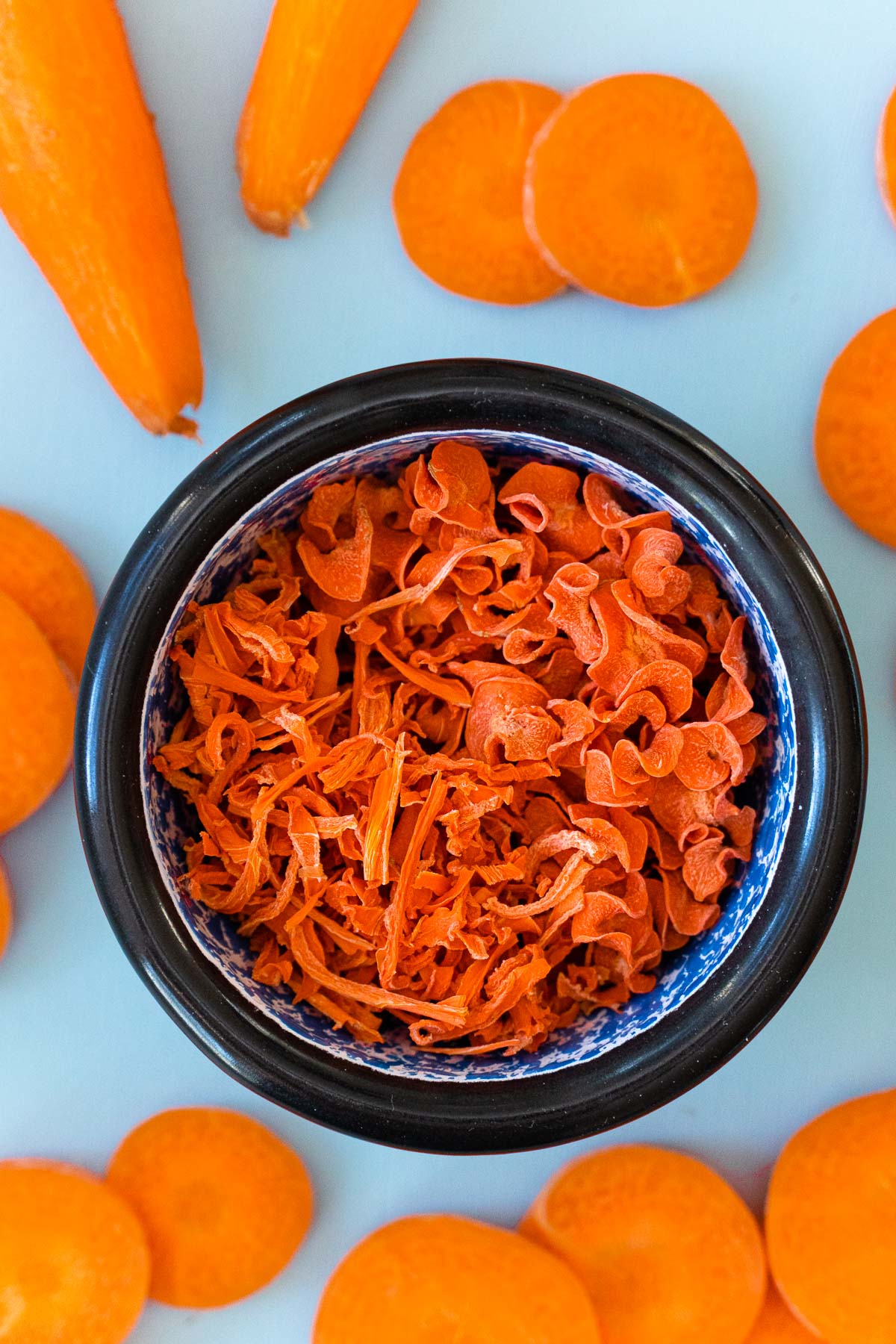
Even though carrots are available in the supermarket year-round and can last for quite a long time in the fridge, there are still a lot of reasons to consider dehydrating them.
Dehydrated carrots that have been properly sealed are shelf-stable for upwards of a year and much lighter weight than fresh carrots. They retain their bright orange color, sweet taste, and many of their nutrients through the dehydration process. And they only need to be soaked in hot water for 15 minutes to rehydrate.
If you have some dehydrated carrots on hand, they are easy to add to homemade soups, stews, braises, or any other dish that will be cooked in a liquid for a little bit. Dehydrated carrots are also a nice way to work some vegetables into your homemade backpacking meals.
So if you want to get started dehydrating carrots, we’ve got everything you need to know below.
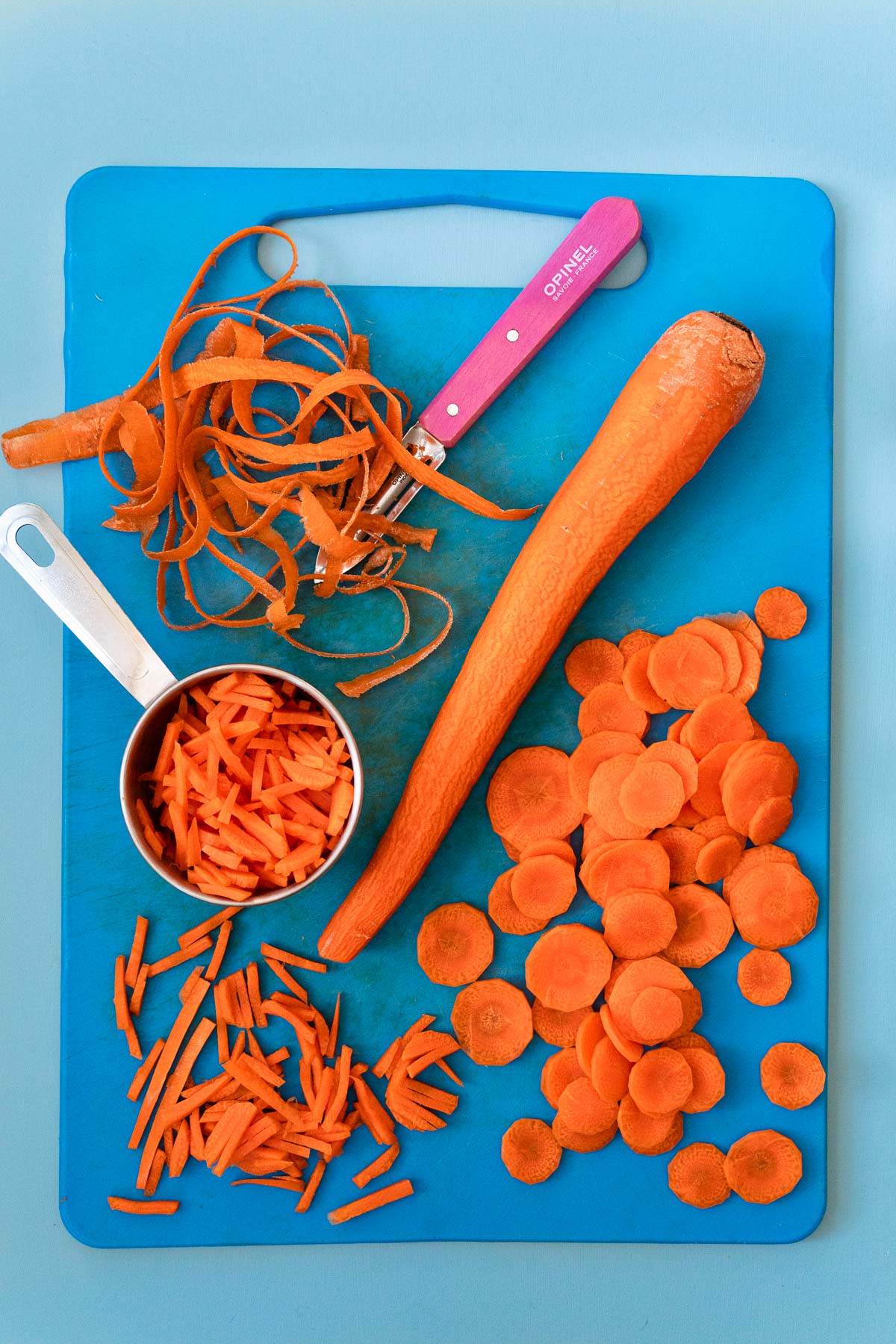
Prepping and Pre-Treating Carrots for Dehydrating
Before you start prepping your carrots, make sure your counters, equipment, and hands are clean & sanitized to prevent contamination, which can spoil your batch down the line.
- Using a sharp knife, remove the tops of your carrots. The brown cap towards the top of a carrot can be very bitter, so be sure to trim it off.
- Peel the carrot’s skin. This too can develop a slightly bitter taste after being dehydrated.
- Wash carrots to remove any sandy residue that might remain.
- For slices: Cut the bottom of the carrot into 1/8 inch rounds. As you work your way up the carrot the pieces will get larger. Once the pieces are the size of a nickel, cut the carrot lengthwise and continue by cutting 1/8 half-moons.
- For shreds: Use the large holes on a box grater to shred the carrot.
- Pretreating carrots is optional. If desired, boil the carrots in water for 2 minutes, then remove and immediately run under cold water.
Your carrots are now ready to be dehydrated!
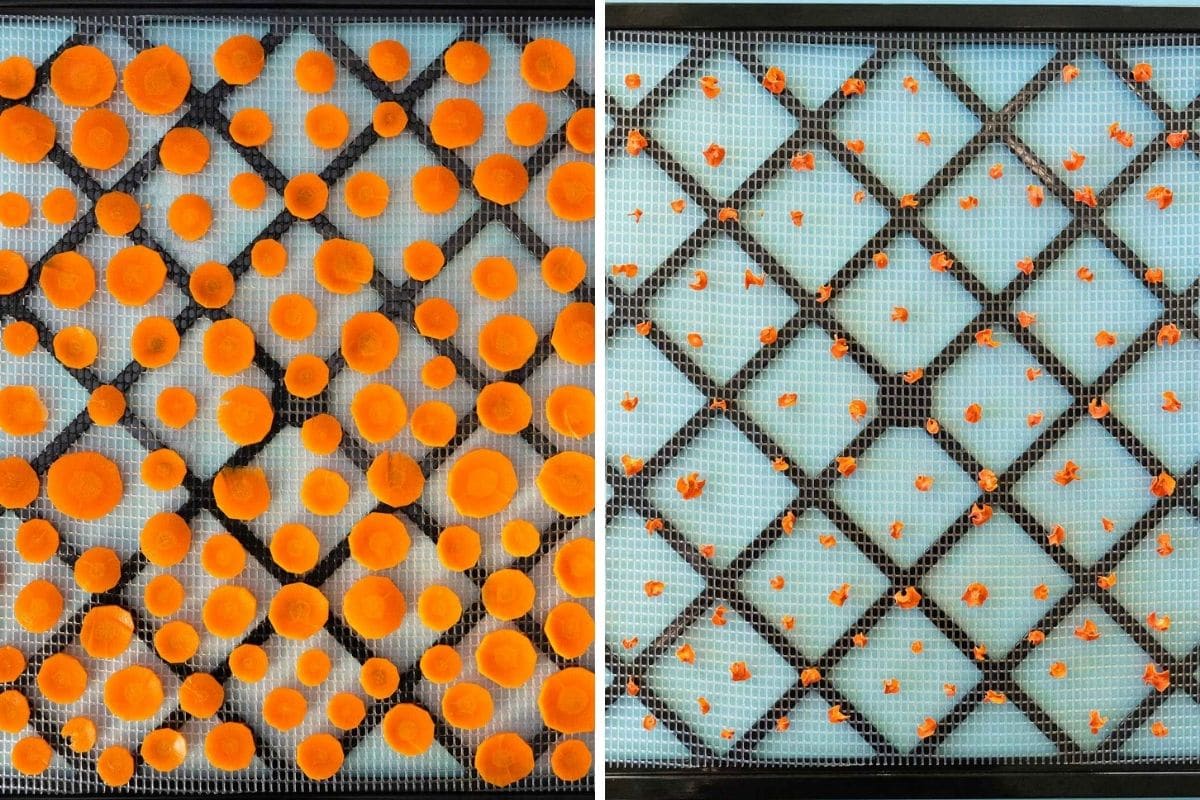
How to Dehydrate Carrots
Arrange the carrots on your dehydrator trays using a mesh liner or parchment paper. Carrots shrink a lot when dehydrated and will fall through dehydrator trays with larger holes.
- Spread the carrots into an even layer. You don’t want them to be touching or overlapping.
- Dehydrate at 125ºF (52ºC) for 8-12 hours until the carrots are dry and hard—they should not be soft or squishy and they should snap, not bend.
- Depending on your machine, you may need to rotate the trays every so often to promote even drying.
Equipment Spotlight: Dehydrators
If you’re in the market for a dehydrator, we recommend buying one with an adjustable temperature. This will allow you to dial in the drying temp to give you the best results for individual ingredients. The dehydrator we recommend (and use) most often is the COSORI dehydrator. You can also check out our best dehydrators post for a comparison of all the dehydrators we’ve used and would recommend.
How to Tell When Carrots are Done
Carrots should be hard and/or brittle when they are completely dried. To test, let them cool, then try to squeeze a piece between your fingers. It should be hard when squeezed. Slices should break, not bend.
If it is soft, spongy, bendy, or you see any moisture squeezing out, then the carrots need to be dehydrated for longer.
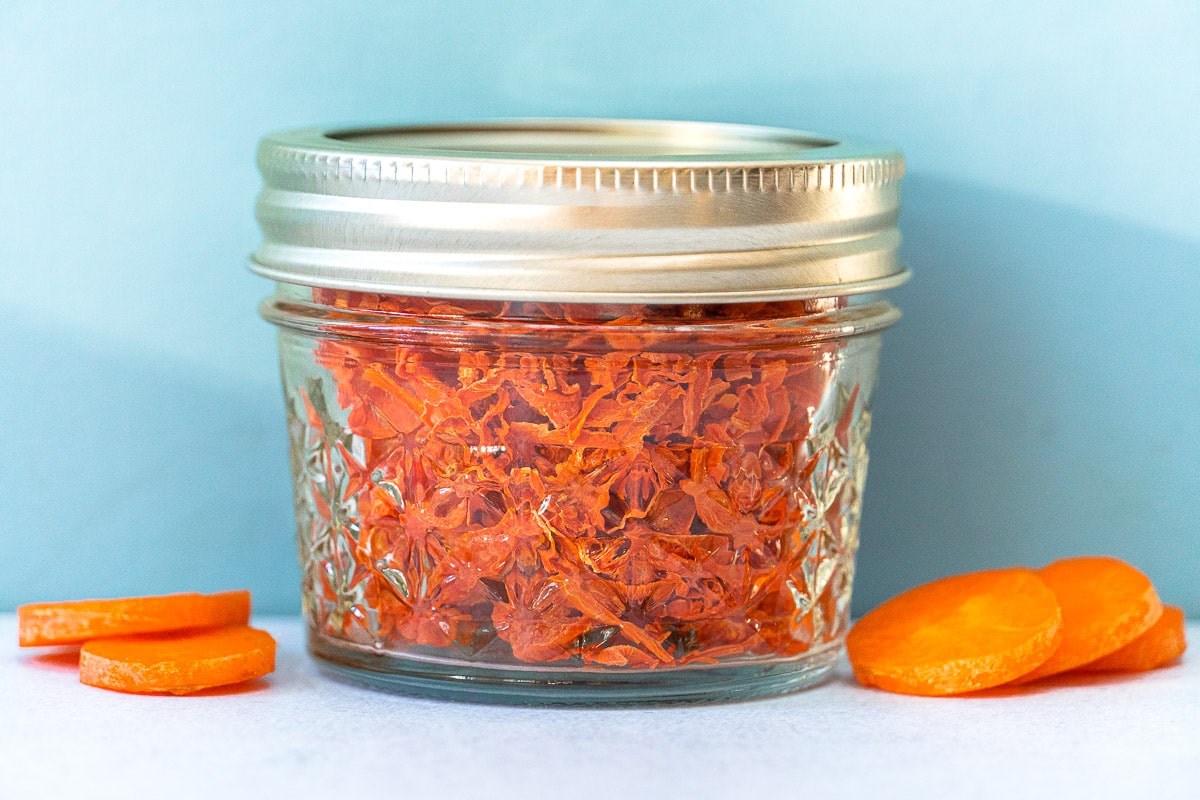
How to store dehydrated carrots
When properly dried and stored, dehydrated carrots can last upwards of a year. Here are our tips for storage:
- Let the carrots cool completely before transferring them.
- Store in a clean, airtight container. For longer shelf life, vacuum seal.
- Use a moisture absorbing desiccant packet if you anticipate opening the container often, or if you live in an area with high humidity.
- Label the container with the date and any other important details
- Place the container in a cool, dark, and dry place—inside of a pantry cabinet works well.
Vacuum Sealing Tips
We like to store our dehydrated food in mason jars that have been vacuum-sealed using this handheld FoodSaver vacuum sealer along with these jar sealing attachments. This gives us the benefit of vacuum sealing without the waste (and expense) of plastic vacuum sealing bags. Since the jars are clear we make sure we store them in a dark spot in our pantry to keep them out of direct light.
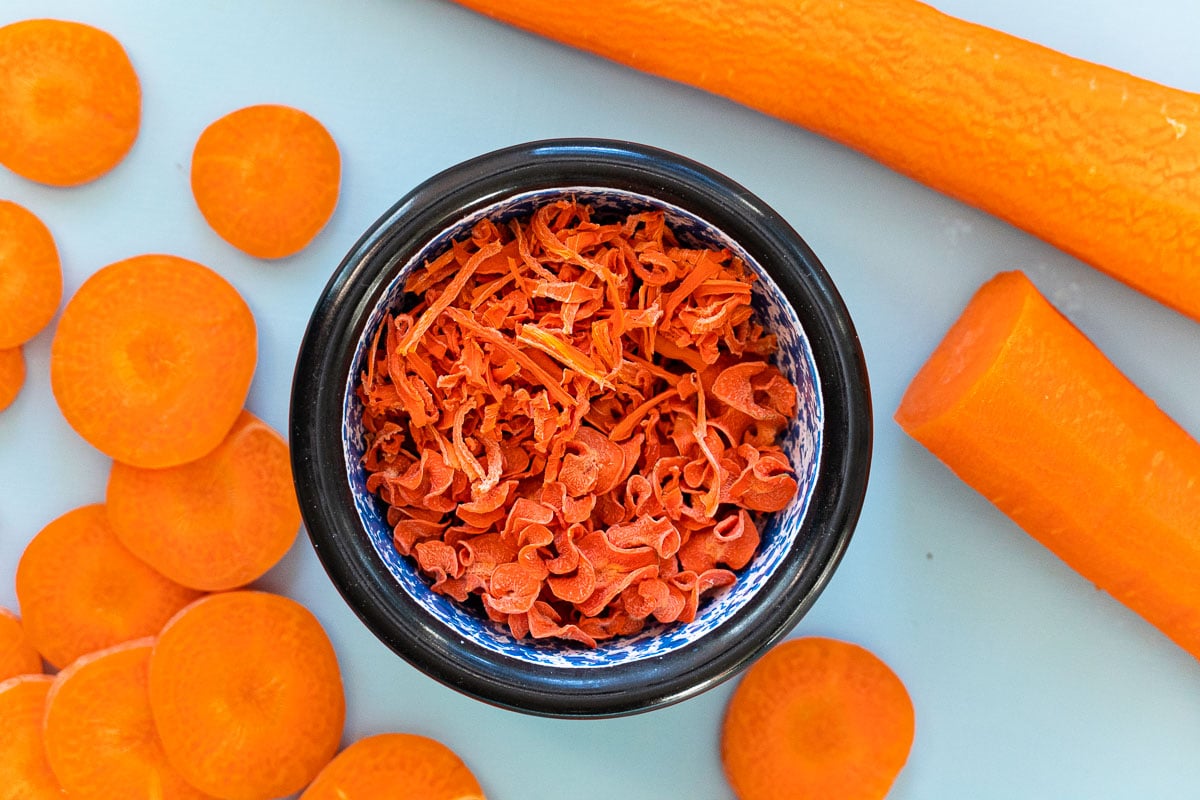
How to use
To rehydrate dried carrots, add them to boiling water for 10-15 minutes, or use them in meals that are liquidy and will cook for a bit.
Here are a few ideas on how to use dehydrated carrots:
- Add to soups, stews, or casseroles
- Rehydrated and use in fried rice
- Add rehydrated carrot shreds to marinara sauce to sneak in some veggies
- Rehydrate shreds and use in carrot bread or muffins
- Dehydrated Minestrone Soup
- Veggie add-in for DIY Ramen
Fresh to dry conversions
1 cup (115g) fresh = 3 tablespoons (6g) dried16 cal 0 fat 4 carb 0 protein 123mg pot.

Dehydrated Carrots
Ingredients
Equipment
Instructions
- Start with clean hands, equipment, and countertops.
- Peel, wash, and slice the carrots—For carrot slices: Using a sharp knife or mandoline, cut the zucchini into ⅛" slices. From there, you can cut them into half-moons or quarter slices if you like.For carrot shreds: Use the large holes of a box grater and shred the carrot.
- Arrange the carrots on dehydrator trays, utilizing a mesh liner to prevent the carrots from falling through the holes as it shrinks.
- Dehydrate at 125ºF (52ºC) for 8-12 hours until the carrots are dry and brittle—they should break, not bend (see note 2).
Storage Tips
- Let the dried carrots cool completely before storing.
- Short-term storage: If carrots will be consumed within a few weeks, store in a ziptop bag or sealed container on the counter or in a pantry.
- Long-term storage: Condition by loosely packing the dried carrots in a transparent, airtight container. Leave it on the counter for a week and check it daily for signs of moisture. If condensation appears, return the carrots to the dehydrator (unless there are signs of mold—then, throw out the whole batch). Shake occasionally to keep the pieces from sticking together.
- After conditioning, store in an airtight container in a cool, dark place for up to a year. Vacuum sealing will help extend the shelf life and quality of the carrots.
